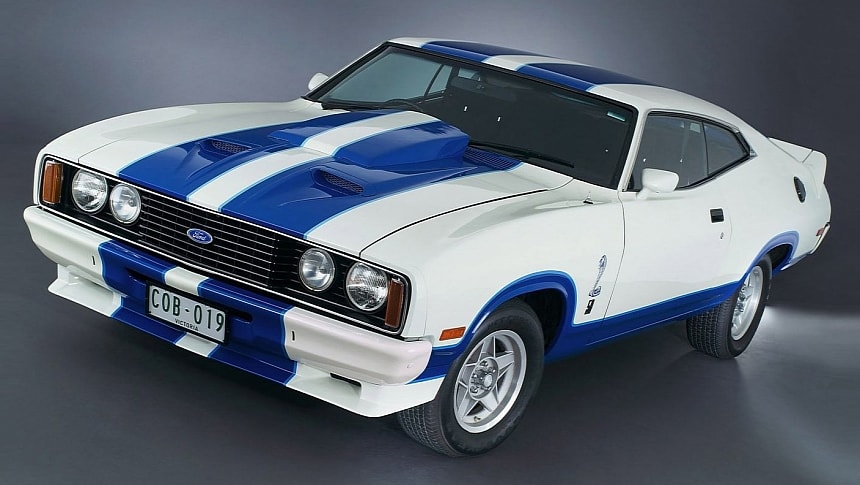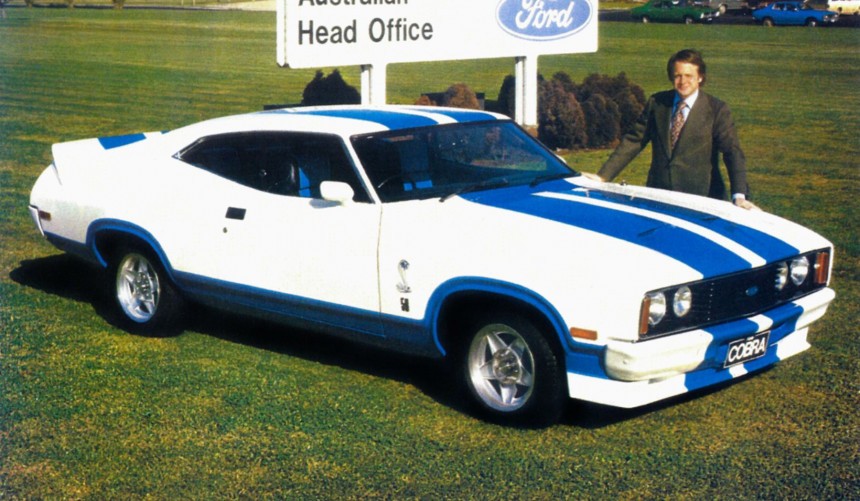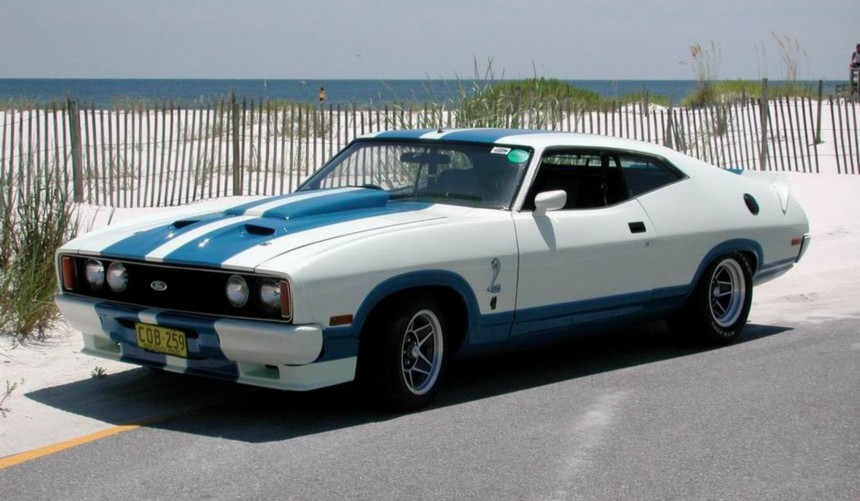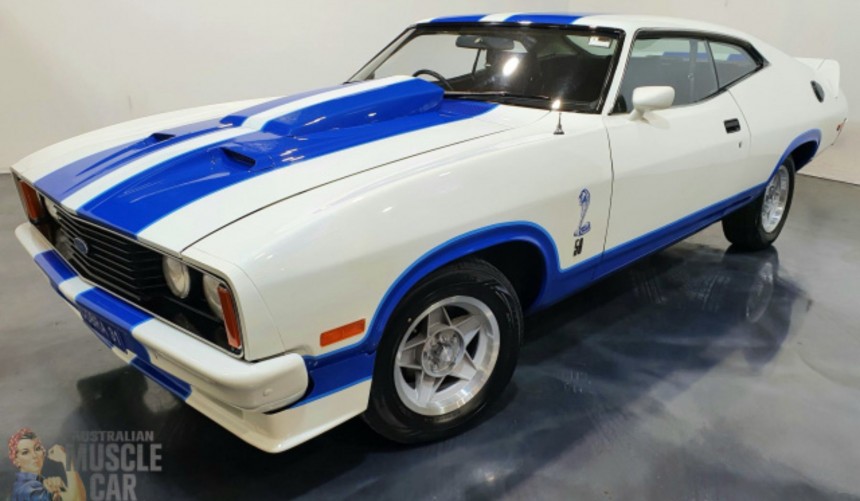While the Malaise era wreaked havoc on the American automotive industry's high-performance sector, Ford kept the flame burning in Australia with one of the most iconic muscle cars ever built.
Some purists have a deep-rooted conviction that a muscle car is an American two-door, V8-powered, high-performance intermediate based on an affordable model. Anything that doesn't adhere to these attributes can't be described as a genuine muscle car.
Yet, throughout history, numerous examples have served to prove them wrong. Take the Boss 429, Boss 302, or Shelby Mustangs, for example. Though essentially pony cars, they packed some serious muscle.
Then there are the HEMI 'Cudas, the Yenko Novas, or, more recently, the Hellcat Chargers - models that became muscle car icons even if they were based on smaller platforms or featured four doors.
Furthermore, some epic high-performance cars were developed during the golden age of muscle outside the US, mainly in Australia. By the strict and, in my opinion, ignorant definition, they're not genuine muscle cars because they weren't American-made.
However, even if you're one of the most stubborn American purists, once you get to know one of these Aussie icons, you'll agree that the muscle car was not a US-exclusive phenomenon.
One of the best examples of a thoroughbred Australian muscle car is the Ford Falcon Cobra, a limited-edition model developed at a time when American muscle was at an all-time low in terms of performance.
By 1978, the Malaise era was in full swing in the US. Due to stringent emission regulations and a ravaging oil crisis, Detroit's big three shifted focus from high-powered tire shredders to plebian econocars.
An accurate illustration of this was the iconic Mustang, which went from a 300+ hp big-block V8-powered muscle car icon to a Pinto-based compact that, in its most potent guise (the 1978 King Cobra), featured a 302-ci (4.9-liter) Windsor V8 chocked to 139 hp (SAE net).
In Australia, however, the local Ford branch had other plans. Like the Mustang II, the XC Falcon, one of its most popular models, was about to be replaced by a thoroughly redesigned model (the XD) in 1979.
With the new Falcon set to debut without a two-door fastback (officially called Hardtop) body style and sales of the current XC hardtops dropping at an accelerated pace, Ford had an estimated stock of around 550 partially assembled Hardtop body shells lying around.
In a Product Committee meeting held in the early days of 1978, the Sales and Marketing team estimated that only about 100 to 150 of the remaining hardtops were scheduled to be ordered by dealerships that year.
That led to a surplus of around 400 units that Ford just couldn't sell. Consequently, one of the main points of that meeting was to find a way to sell those surplus Hardtop shells.
The first idea was to build a special edition, all-black Playboy Hardtop adorned with the adult magazine's logos and a bespoke interior finish.
Of course, that idea was swiftly rejected since it would've gone against Ford's family-friendly image, but then, Edsel Ford II, who was Ford Australia's new Sales and Marketing head, proposed a limited-edition Cobra model inspired by the American Shelby Mustangs of the 1960s.
Though the idea of a heavily American-inspired edition of the Falcon didn't go well with most of the members, they eventually agreed with Edsel's proposal, probably because he was the great-grandson of the company founder.
Heavily inspired by the American Torino fastback, the smaller Falcon Hardtop was introduced in 1972, becoming the first sporty two-door fastback designed and built in Australia.
For the next six years, the Hardtop went through a series of improvements and featured several performance-oriented editions, but none were as exciting and aggressive-looking as the Cobra.
Compared to the standard XC Falcon Hardtop, the limited-edition Cobra received a special Sno White finish with contrasting Bold Blue twin stripes that ran across the body and, of course, distinct Cobra logos.
In addition, the package (dubbed Option 96) also added a front lip spoiler, 15-inch Bathurst Globe alloy wheels, a dual-vent hood, and a fiberglass rear decklid spoiler.
Inside, the Cobra came with bespoke black and blue Onkaparinga cloth upholstery, a material scheduled to be used on the forthcoming XD Falcon, and a unique production number plaque fitted on the glovebox lid.
Though not exclusive to the Cobra, the limited-edition Falcon was powered by Ford's Australia's most potent V8s.
The first 200 units built at Ford's Broadmeadows Assembly Plant were equipped with the Aussie version of the 351-ci (5.8-liter) four-barrel Cleveland rated at 217 hp (SAE net), while the latter 200 (allegedly with one exception) received the 302-ci (4.9-liter) four-barrel that made 202 hp (SAE net).
Those figures weren't all that impressive, particularly when compared to pre-1972 American muscle cars. However, since those iconic models had power plants with outputs rated using the SAE gross system, the figures were at least 25% higher than the net ratings.
Moreover, the oil crisis and stringent emission regulations also affected Australian production cars, so by 1978 standards, the Falcon Cobra packed some serious muscle.
Apart from the V8s, available with either a four-speed manual or a three-speed automatic, the Cobra received a limited-slip differential, a touring suspension package, and four-wheel disc brakes.
To boost sales of the limited edition, Ford aimed to compete with the Falcon Cobra in the Australian Championship of Makes, but a minimum of 30 street-legal cars had to feature the permitted race upgrades to be competitive and gain Australian Motor Sport (CAMS) homologation.
Thus, of the 400 Falcon Cobras, 30 were equipped with these modifications. Called Option 97, but known in Australia as the Bathurst special, the package equipped on those 30 cars included redesigned rear wheel wells to allow wider tires, reinforced front shock towers and strut braces, a beefed-up suspension cross member, a bespoke fiberglass front spoiler, and a scooped fiberglass hood.
Furthermore, the engine received a heavy-duty radiator, the transmission got an external oil cooler, and the stock front seats were swapped with lighter, all-black Scheel KBA90018 buckets.
Despite initial fears that it was too American for the Australian muscle car enthusiasts, The Falcon Cobra became a marketing hit. All 400 units were quickly ordered by dealerships and they left the showroom floor as soon as they arrived.
Today, the Falcon Cobra is one of the most legendary Australian muscle cars ever developed and, I dare say, one of the greatest muscle cars ever built anywhere in the world.
Surviving examples are prized collectors' items, with the Bathurst specials being unquestionably the most sought-after.
For a virtual tour of a surviving Falcon Cobra and more info about this iconic Aussie muscle car, we recommend watching the YouTube videos below by The Roaring Season.
Yet, throughout history, numerous examples have served to prove them wrong. Take the Boss 429, Boss 302, or Shelby Mustangs, for example. Though essentially pony cars, they packed some serious muscle.
Then there are the HEMI 'Cudas, the Yenko Novas, or, more recently, the Hellcat Chargers - models that became muscle car icons even if they were based on smaller platforms or featured four doors.
Furthermore, some epic high-performance cars were developed during the golden age of muscle outside the US, mainly in Australia. By the strict and, in my opinion, ignorant definition, they're not genuine muscle cars because they weren't American-made.
However, even if you're one of the most stubborn American purists, once you get to know one of these Aussie icons, you'll agree that the muscle car was not a US-exclusive phenomenon.
One of the best examples of a thoroughbred Australian muscle car is the Ford Falcon Cobra, a limited-edition model developed at a time when American muscle was at an all-time low in terms of performance.
By 1978, the Malaise era was in full swing in the US. Due to stringent emission regulations and a ravaging oil crisis, Detroit's big three shifted focus from high-powered tire shredders to plebian econocars.
An accurate illustration of this was the iconic Mustang, which went from a 300+ hp big-block V8-powered muscle car icon to a Pinto-based compact that, in its most potent guise (the 1978 King Cobra), featured a 302-ci (4.9-liter) Windsor V8 chocked to 139 hp (SAE net).
From Playboy to Cobra
With the new Falcon set to debut without a two-door fastback (officially called Hardtop) body style and sales of the current XC hardtops dropping at an accelerated pace, Ford had an estimated stock of around 550 partially assembled Hardtop body shells lying around.
In a Product Committee meeting held in the early days of 1978, the Sales and Marketing team estimated that only about 100 to 150 of the remaining hardtops were scheduled to be ordered by dealerships that year.
That led to a surplus of around 400 units that Ford just couldn't sell. Consequently, one of the main points of that meeting was to find a way to sell those surplus Hardtop shells.
The first idea was to build a special edition, all-black Playboy Hardtop adorned with the adult magazine's logos and a bespoke interior finish.
Of course, that idea was swiftly rejected since it would've gone against Ford's family-friendly image, but then, Edsel Ford II, who was Ford Australia's new Sales and Marketing head, proposed a limited-edition Cobra model inspired by the American Shelby Mustangs of the 1960s.
Though the idea of a heavily American-inspired edition of the Falcon didn't go well with most of the members, they eventually agreed with Edsel's proposal, probably because he was the great-grandson of the company founder.
The most aggressive-looking Falcon Hardtop of them all
For the next six years, the Hardtop went through a series of improvements and featured several performance-oriented editions, but none were as exciting and aggressive-looking as the Cobra.
Compared to the standard XC Falcon Hardtop, the limited-edition Cobra received a special Sno White finish with contrasting Bold Blue twin stripes that ran across the body and, of course, distinct Cobra logos.
In addition, the package (dubbed Option 96) also added a front lip spoiler, 15-inch Bathurst Globe alloy wheels, a dual-vent hood, and a fiberglass rear decklid spoiler.
Inside, the Cobra came with bespoke black and blue Onkaparinga cloth upholstery, a material scheduled to be used on the forthcoming XD Falcon, and a unique production number plaque fitted on the glovebox lid.
Powered by two versions of the Aussie Cleveland V8
{fulimg10}Though not exclusive to the Cobra, the limited-edition Falcon was powered by Ford's Australia's most potent V8s.
The first 200 units built at Ford's Broadmeadows Assembly Plant were equipped with the Aussie version of the 351-ci (5.8-liter) four-barrel Cleveland rated at 217 hp (SAE net), while the latter 200 (allegedly with one exception) received the 302-ci (4.9-liter) four-barrel that made 202 hp (SAE net).
Those figures weren't all that impressive, particularly when compared to pre-1972 American muscle cars. However, since those iconic models had power plants with outputs rated using the SAE gross system, the figures were at least 25% higher than the net ratings.
Moreover, the oil crisis and stringent emission regulations also affected Australian production cars, so by 1978 standards, the Falcon Cobra packed some serious muscle.
Apart from the V8s, available with either a four-speed manual or a three-speed automatic, the Cobra received a limited-slip differential, a touring suspension package, and four-wheel disc brakes.
The Bathurst special
Thus, of the 400 Falcon Cobras, 30 were equipped with these modifications. Called Option 97, but known in Australia as the Bathurst special, the package equipped on those 30 cars included redesigned rear wheel wells to allow wider tires, reinforced front shock towers and strut braces, a beefed-up suspension cross member, a bespoke fiberglass front spoiler, and a scooped fiberglass hood.
Furthermore, the engine received a heavy-duty radiator, the transmission got an external oil cooler, and the stock front seats were swapped with lighter, all-black Scheel KBA90018 buckets.
Despite initial fears that it was too American for the Australian muscle car enthusiasts, The Falcon Cobra became a marketing hit. All 400 units were quickly ordered by dealerships and they left the showroom floor as soon as they arrived.
Today, the Falcon Cobra is one of the most legendary Australian muscle cars ever developed and, I dare say, one of the greatest muscle cars ever built anywhere in the world.
Surviving examples are prized collectors' items, with the Bathurst specials being unquestionably the most sought-after.
For a virtual tour of a surviving Falcon Cobra and more info about this iconic Aussie muscle car, we recommend watching the YouTube videos below by The Roaring Season.






